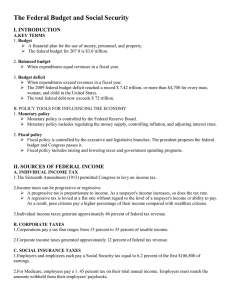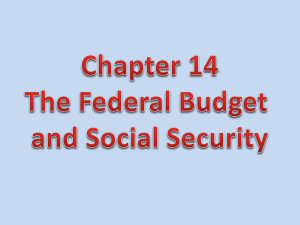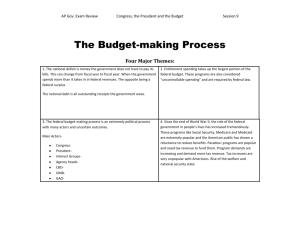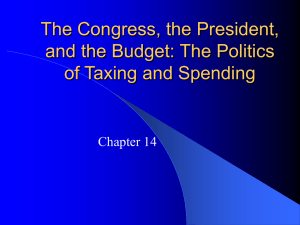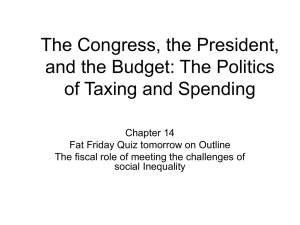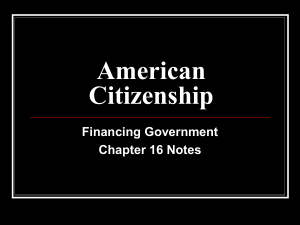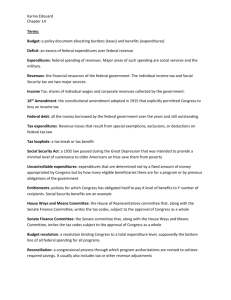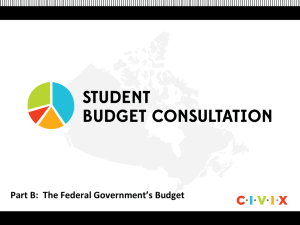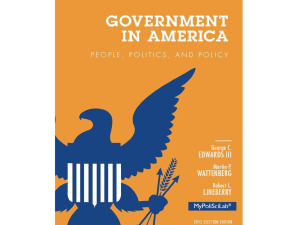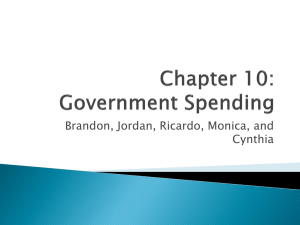File
advertisement
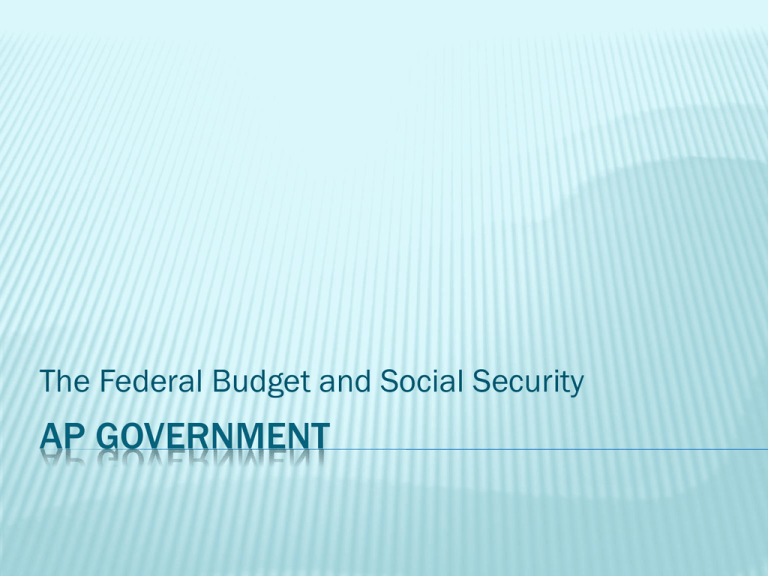
The Federal Budget and Social Security AP GOVERNMENT INTRODUCTION Key Terms Budget A financial plan for the use of money, personnel, and property. Balanced Budget When expenditures equal revenues in a fiscal year. Budget Deficit When expenditures exceed revenues in a fiscal year. The 2009 federal budget deficit reached a record $1.42 trillion, or more than $4,700 for every man, woman, and child in the United States. The total federal debt now exceeds $12 trillion. INTRODUCTION Policy Tools For Influencing The Economy Monetary Policy Monetary policy is controlled by the Federal Reserve Board. Monetary policy includes regulating the money supply controlling inflation, and adjusting interest rates. Fiscal Policy Fiscal policy is controlled by the executive and legislative branches. The president proposes the federal budget and Congress passes it. Fiscal Policy includes raising and lowering taxes and government spending programs. SOURCES OF FEDERAL INCOME Individual Income Tax The Sixteenth Amendment (1913) permitted Congress to levy an income tax. Income taxes can be progressive or regressive. A progressive tax is proportionate to income. As a taxpayer’s income increases, so does the tax rate. A regressive tax is levied at a flat rate without regard to the level of a taxpayer’s income or ability to pay. As a result, poor citizens pay a higher percentage of their income compared with wealthier citizens. Individual income taxes generate approximately 46% of federal tax revenue. SOURCES OF FEDERAL INCOME Corporate Taxes Corporations pay a tax that ranges from 15% to 35% of taxable income. Corporate income taxes generate approximately 12% of federal tax revenue. SOURCES OF FEDERAL INCOME Social Insurance Taxes Employers and employees each pay a Social Security tax equal to 6.2% of the first $106,800 of earnings. For Medicare, employees pay a 1.45% tax on their total annual income. Employers must match the amounts withheld from their employee’s paychecks. The Social insurance taxes are regressive because they are levied at a fixed rate without regard to the level of a taxpayer’s income. Social insurance taxes now generate approximately 36% of federal tax revenue. SOURCES OF FEDERAL INCOME Excise Taxes An excise tax is a tax on the manufacture, sale, or consumption of a good or service. Federal excise taxes are currently imposed on the sale of gasoline, tobacco, alcohol, airline tickets, and many other goods and services. Excise taxes currently generate approximately 2.7% of federal tax revenue. SOURCES OF FEDERAL INCOME Estate and Gift Taxes An estate tax is a levy imposed on the assets of someone who dies. A gift tax is a levy imposed on a gift from a living person to another. Estate taxes currently generate 1.2% of federal tax revenue. Custom Duties Custom duties or tariffs are taxes levied on goods brought into the United States from abroad. Prior to the income tax, custom duties were the federal government’s most important source of income. They currently generate just 1.1% of federal tax revenue. FEDERAL EXPENDITURES Uncontrollable Spending Congress and the president have no power to directly change uncontrollable spending. Over 60% of all federal spending now falls into the uncontrollable category. Entitlement programs A federal entitlement is a program that guarantees a specific level of benefits to persons who meet requirements set by law. Social Security, Medicare, Medicaid, food stamps, unemployment insurance, and veteran’s pensions and benefits are the largest entitlement programs. Entitlement programs are by far the largest portion of uncontrollable spending in the federal budget. Social Security, Medicare, and Medicaid are now responsible for approximately 44% of all federal expenditures. FEDERAL EXPENDITURES TEST TIP Be sure to understand that entitlement programs represent the largest portion of uncontrollable spending in the federal budget. Entitlements thus represent a formidable barrier to achieving a balanced budget. FEDERAL EXPENDITURES Uncontrollable Spending (cont.) Borrowing The federal debt now exceeds $12 trillion. Approximately 5% to 9% of all federal expenditures go to paying interest on the debt. It is important to note that the amount of money spent servicing the debt depends on interest rates. If interest rates rise, then the amount required to service the debt will also rise. Discretionary Spending Discretionary spending programs are not required by law. Defense, education, agriculture, highways, research grants, and government operations are all examples of discretionary programs. Defense currently accounts for approximately 20% of the total federal budget. THE BUDGETARY PROCESS The President and the Budget The president initiates the budget process by submitting a proposed budget to Congress. The Office of Management and Budget (OMB) has the primary responsibility for preparing the federal budget. The budget reflects the priorities and goals of the president’s policy agenda. THE BUDGETARY PROCESS Congress and the Budget The Congressional Budget and Impoundment Control Act of 1974 Designed to reform the congressional budgetary process and regain power previously lost to the executive branch. Created a fixed budget calendar. Established a budget committee in each house of Congress. Created the Congressional Budget Office (CBO) to advise Congress by forecasting revenues and evaluating the probable consequences of budget decisions. THE BUDGETARY PROCESS Congress and the Budget (cont.) The president’s budget is sent to both the House and Senate Appropriations Committees, which hold hearings on key items. All tax proposals are referred to the House Ways and Means Committee and to the Senate Finance Committee. Congress is required to pass 13 major appropriations bills by the beginning of the federal government’s fiscal year on October 1st. THE BUDGETARY PROCESS Budget Barriers To Achieving a Balanced Budget Entitlement programs now account for over 60% of the total federal budget. This limits what the president and Congress can do to achieve a balanced budget. Federal agencies assume that their annual budgets will increase by a small amount each year. This process of small but regular increases is called incrementalism. Because it is built into the budgetary process, it is very difficult to make spending cuts. The fragmented federal system enables interest groups to successfully resist tax increases and defend favored programs. THE BUDGETARY PROCESS Consequences of Budget Deficits Budget deficits require huge interest payments. In 2008, the federal government paid $249 billion just to service the debt. Budget deficits will place a heavy burden on future generations. Budget deficits make it difficult to fully fund key policy goals. SOCIAL SECURITY Background Franklin D. Roosevelt signed the Social Security Act into law in 1935. In 1965, Congress added Medicare to the Social Security program. Medicare is designed to assist the elderly with medical costs. Social Security and Medicare are the most expensive programs in the federal budget. Along with Medicaid, they currently comprise approximately 44% of all federal expenditures. SOCIAL SECURITY Demographic Trends That Threaten The Future OF The Social Security Program When the Social Security program began, there were 25 workers for every 1 beneficiary. Today the ratio is 3.3 workers for every 1 beneficiary. The Baby Boom generation includes 76 million people born between 1946 and 1964. As the Baby Boom generation begins to retire, the number of workers who fund Social Security will decline while the number of people eligible for Social Security benefits will increase. As a result of improved health care, average life expectancy is increasing. This will put additional pressure on the Social Security system. SOCIAL SECURITY TEST TIP AP U.S. Government and Politics exams have thus far not devoted any multiple-choice or freeresponse questions to foreign policy and national security. In contrast, they have devoted a number of questions to Social Security. It is very important for you to study the demographic forces that are combining to threaten solvency of the Social Security system.
